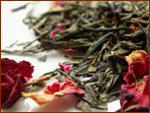
Tea is produced in over 20 Chinese provinces. Chinese tea bushes (Camellia sinensis) are cultivated in the mountainous areas of tropical and subtropical regions and elsewhere where there is proper climate, sufficient humidity, adequate sunshine and fertile soil. Chinese tea is classified in many ways, e.g. quality, method of preparation or place of production. The main processing methods include fermentation (oxidation), heating and drying.
Tea that has not been fermented is called "green tea." Tea steeped from green tea leaves is jade green to yellow-green in color, and gives off the fragrance of fresh vegetables. Examples of green tea are "Dragon Well" (Lung-ching) and "Green Snail Spring" (Pi-lo-ch'un). The tea that undergoes full fermentation is called "red tea" (hung-ch'a); in the West, this is known as "black tea." Tea made from black tea leaves is reddish-brown in color and has a malt-like aroma. Oolong, or "Black Dragon" (Wu-Lung) tea is an example of a partially-fermented tea.
Various preparation methods mean different teas have different bioactive substances. For example, green tea has limited processing, hence retaining a relatively high content of natural ingredients. This gives green tea stronger anti-aging, anti-cancer and anti-bacterial properties. Oolong tea, which is partially fermented, is quite potent in breaking down protein and fat, aiding weight loss. Red tea that has undergone the full fermentation process has lost 90% of its polyphenols but retains its high caffeine content.